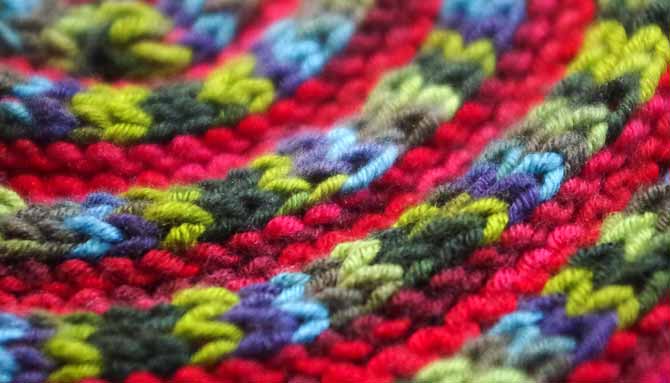This week we’re using Allegro and Naked Sock, two non-allergenic yarns, in our exploration of I-cord, in this case, how to use it for casting on.

When I-cord is used as a cast-on edge the result is a neat finish.
In yesterday’s post, I showed you how to knit on an i-cord edging to existing stitches. But looking at the above photo, you really wouldn’t be able to tell for sure whether I knit this blue-and-green i-cord onto the red garter stitch, but I’ll tell you that I didn’t.
Instead, I made the i-cord first, and then with the Cardinal Rule colorway of Naked Sock, I added the stitches of the main part of the swatch.
To do this, you need to look carefully at the stitches in the I-cord and decide whether you want to use the upper strand of a horizontal stockinette V-stitch or the lower, and then you need to be consistent as you work along the I-cord, always lifting the same strand of the “V”.
How long should you make your i-cord cast on? Well, you’ll need to do a bit of math. First, divide the number of stitches required for your knit item. Let’s say it’s a scarf with 55 stitches. Divide this number by 3 and “keep” the remainder aside.
55 divided by 3 = 18 with a remainder of 1.
Take the answer, in this case 18, and multiply by 4.
18 x 4 = 72, and then add the remainder. 72 + 1 = 73.

You can use an I-cord cast-on to create curved edges.
So you need to work 73 rounds of i-cord for this scarf. When I do this, I could use my cast-on round as one of the needed rounds. At the end of the 73 rounds, I simply run the end of the yarn through the 4 stitches on the needle and cinch them closed. If you were going to make the scarf with the same yarn as the i-cord, do the following instead: k2tog, k2tog, pass the first st over the 2nd. Then you can start to pick up stitches along the i-cord right off the bat.
Pick up 3 stitches for every 4 rounds in the i-cord and you’ll avoid buckling or flaring edges.
I went a little crazy with my experimenting with the i-cord cast-on and ended up with this. Please guess what you think what this will end up being when I’m done knitting it.

A mystery project! What do you think this is going to be?

This piece uses I-cord both as a cast-on and as an edging technique to create an amazing textile.
Using both the technique from yesterday and today’s cast-on in combination yields some amazing results. This motif is from a pattern I fell in love with while browsing through Ravelry called Jewel Dragon. It’s a gorgeous pattern and would really suit the bright colorways of Naked Feet yarn.
Tomorrow I’ll share another design I’ve knit with only 1 skein of Allegro.

One “scale” motif of the Jewel Dragon pattern.
This is part 4 of 5 in this series.
Go back to part 3: How to knit on an I-cord edging

3 comments
I’m an avid knitter who’s been knitting for many years. Thanks for showing me a new technique, can’t wait to try it.
I hope I’ll get that good some day…
I’ve tried knitting and crocheting. I’m not good at either yet, but I try like crazy. This looks like a neat idea.